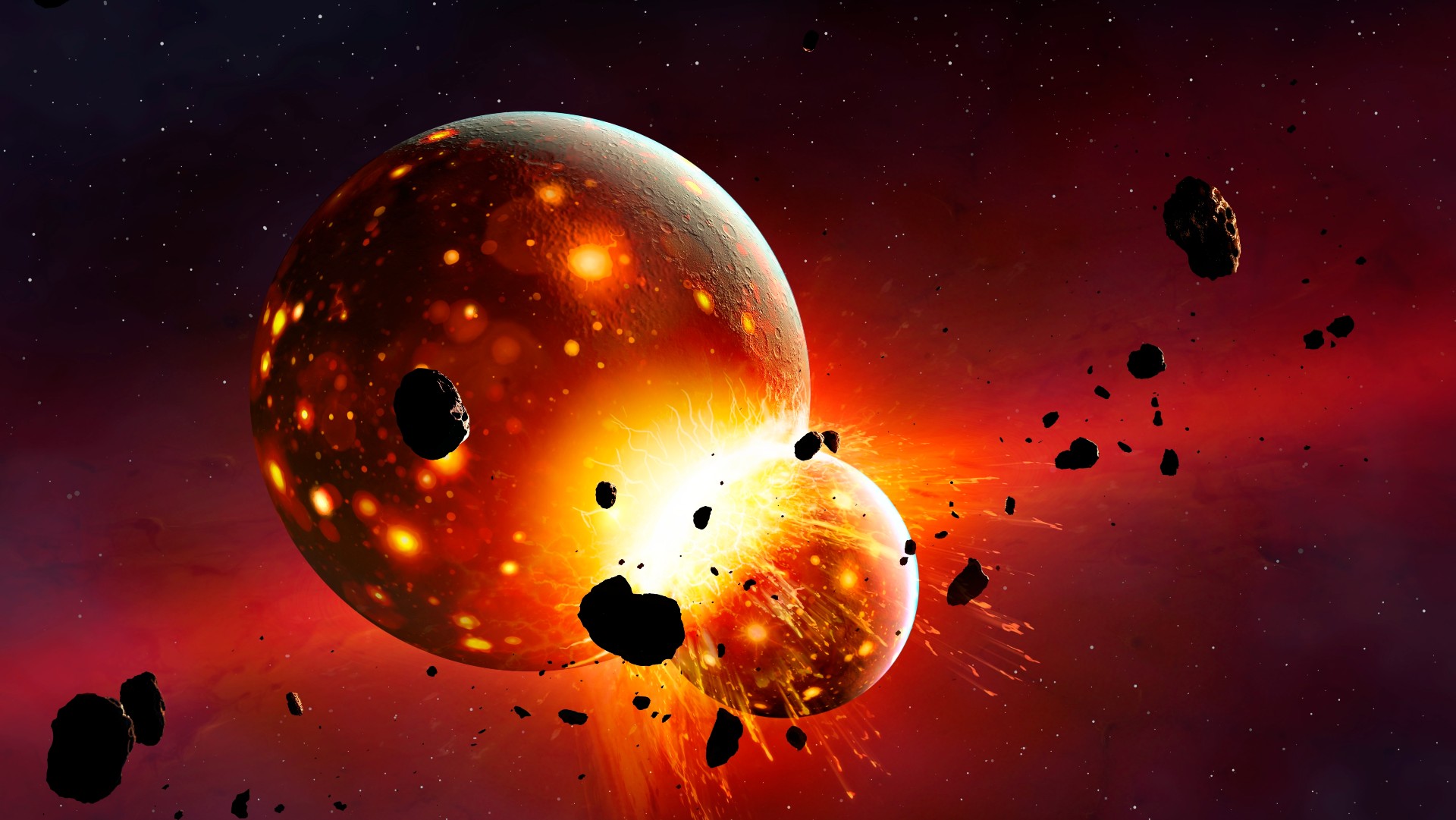A chunk of the 'protoplanet' that made the moon may be stuck near Earth's core
Debris from the impact between Earth and the protoplanet eventually formed the moon.

The newborn Earth was struck by a Mars-size rock that helped create the moon, and the impact may have left behind continent-size remnants of the rock near Earth's core, a new study finds.
Scientists think Earth formed about 4.5 billion years ago, and previous research suggested the moon arose a short time later. The leading explanation for the moon's origin is that it resulted from the collision of two protoplanets, or embryonic worlds. One of those was the young proto-Earth, and the other was a Mars-size rock nicknamed Theia, after the mother of the moon in Greek myth.
This "giant impact hypothesis" suggests the moon coalesced from the debris from this impact. However, direct evidence for the existence of Theia remains elusive. Now, researchers suggest this giant impact may have buried relics of Theia deep within Earth's mantle near the planet's core.
"Our work indicates this giant impact had a long-lasting effect for Earth's whole evolution, and it could potentially explain why Earth is geologically unique compared to other rocky planets," study lead author Qian Yuan, a geodynamicist at the California Institute of Technology in Pasadena, told Space.com.
Related: Ancient impact that formed Earth's moon was likely a one-two punch
In the new study, Yuan and his colleagues investigated two continent-size blobs of rock in the lowermost mantle, about 1,800 miles (2,900 kilometers) below Earth's surface. Previous research found seismic waves rippling through Earth's interior traveled unusually slowly through these anomalies. This suggested they were denser than and differed in composition from the surrounding mantle.
The research team's computer simulations revealed a fraction of Theia's mantle could have made its way to proto-Earth's lower mantle. This rock from Theia would have been 2 to 3.5 percent denser than proto-Earth's mantle, based on what is known from the moon and previous models of Theia.
Get the Space.com Newsletter
Breaking space news, the latest updates on rocket launches, skywatching events and more!
The computer models suggested these dense Theia relics were tens of miles wide. This mostly molten rock could have sunk and solidified over time, accumulating as dense blobs on top of Earth's core equal in weight to about one-fortieth to one-sixtieth of Earth's mass.
These new findings suggest these blobs would be more iron-rich than Earth's normal mantle rock, Yuan said. They could be similar in chemistry to lunar volcanic rock, he added.
Traces of these blobs could make their way to Earth's surface with the aid of mantle plumes, giant mushroom-shaped pillars of super-heated rock that rise up from near Earth's core. Prior work suggested that Iceland and the island chains of Hawaii and the Galapagos formed as tectonic plates slowly drifted over mantle plumes, which seared overlying material like a blowtorch.
"Some traces of the Theia relics could be brought to surface volcanoes by mantle plumes," Yuan said.
Yuan is now investigating whether this pair of blobs may have helped spur on geological activity unique to Earth. Our planet's surface is made of massive tectonic plates, and the way in which these slabs drift, known as plate tectonics, drives earthquakes and volcanoes, creates mountain ranges and islands, and liberates vital elements from rocks. The strongest driving force behind plate tectonics is subduction — when one plate dives under another — and Earth is so far the only planet where subduction is known to occur. Yuan aims to see if these two blobs in the deep mantle could help drive subduction.
The scientists detailed their findings online November 1 in the journal Nature.
Join our Space Forums to keep talking space on the latest missions, night sky and more! And if you have a news tip, correction or comment, let us know at: community@space.com.

Charles Q. Choi is a contributing writer for Space.com and Live Science. He covers all things human origins and astronomy as well as physics, animals and general science topics. Charles has a Master of Arts degree from the University of Missouri-Columbia, School of Journalism and a Bachelor of Arts degree from the University of South Florida. Charles has visited every continent on Earth, drinking rancid yak butter tea in Lhasa, snorkeling with sea lions in the Galapagos and even climbing an iceberg in Antarctica. Visit him at http://www.sciwriter.us
-
rod The paper cited states, "From these results19, we found that a significant amount of TMM, 0.017–0.026 Earth masses (M⊕) (Extended Data Table1), could have entered the lower mantle layer, which is comparable with mass estimates of approximately 0.01–0.06M⊕ for the LLVPs14,20. However, both thermo-dynamics and material mixing are sensitive to the setup of numerical models, including equations of state, numerical resolution and the hydrodynamical method (Methods).", https://www.nature.com/articles/s41586-023-06589-1.epdf?sharing_token=yILoM4ybdb__GzU8cY5pPNRgN0jAjWel9jnR3ZoTv0OUGDu6sS_mNfR5UvQfwmQuhRBG9RUEBCCNnqd9DYb0AXarDa3N59NZ9IDm_ewFHkY49tdP4NXCBP868kz8rp9SEXhc-tA2N68j6gRmimkdhoQQQezphTiybYaCbnpsf74hG7GDdO22oH6EQSvvJKUsQfjb53rlgiEPvEuoXUSwZSVb1Q3y5CMJ16VOxFEQlT3EIyEEIoQY2XiYMBdNNNUK&tracking_referrer=www.space.comReply
I am not sure what the proto-earth mass was used in the simulations reported here and density compared to Theia modeling before the giant impact. I have read some reports where the proto-earth mass before Theia impact ranged some 0.6 to 0.9 present day earth mass. The Moon that formed after the giant impact likely was a smaller mass Moon too, not much reported on questions like this it seems to me.
When it comes to the exoplanet lists, there are no confirmed exomoons that formed via a giant impact it seems.
https://exoplanet.eu/home/https://exoplanetarchive.ipac.caltech.edu/index.html









